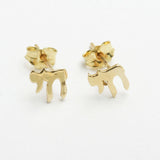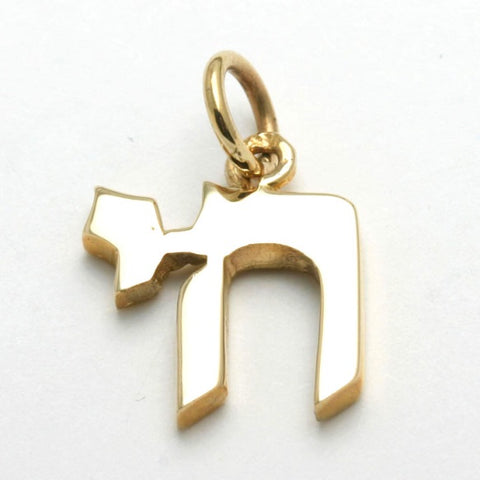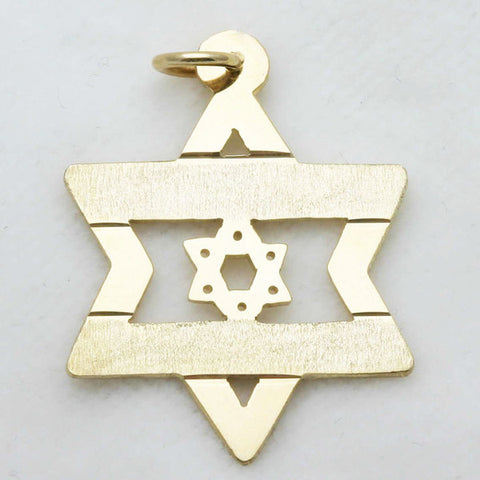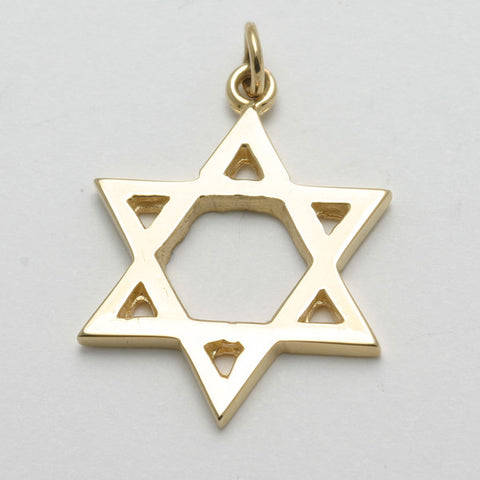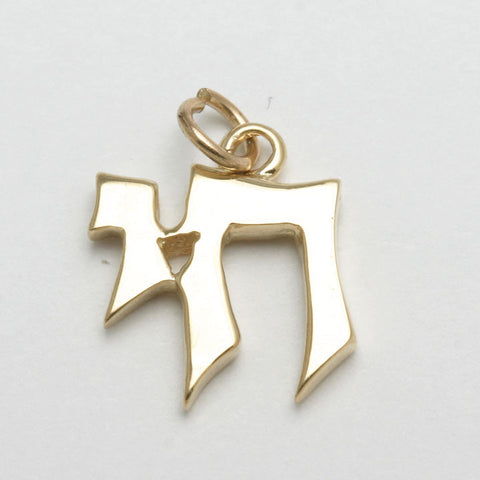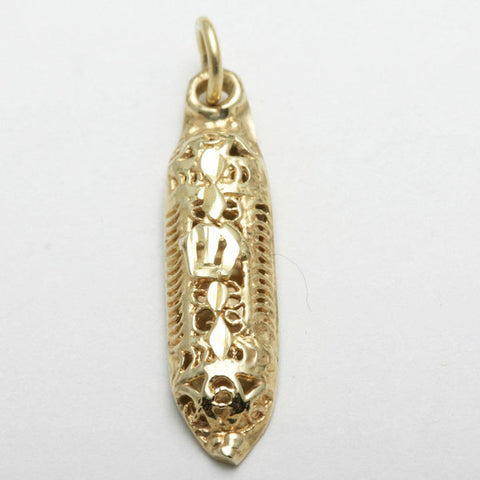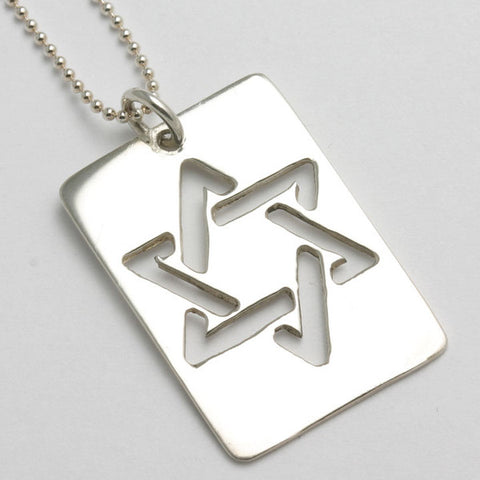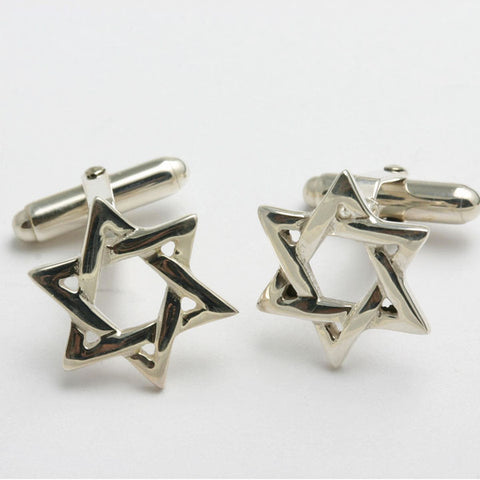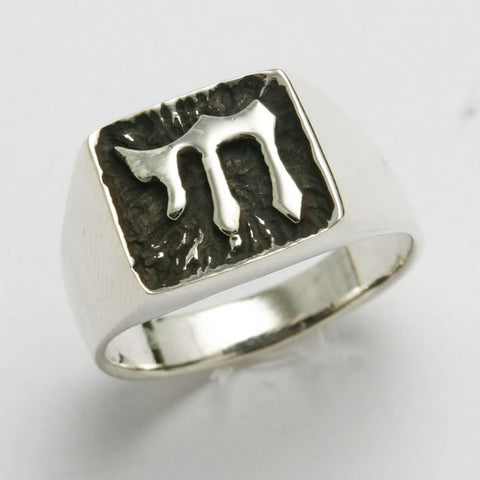The Jewelry Judaica Blog
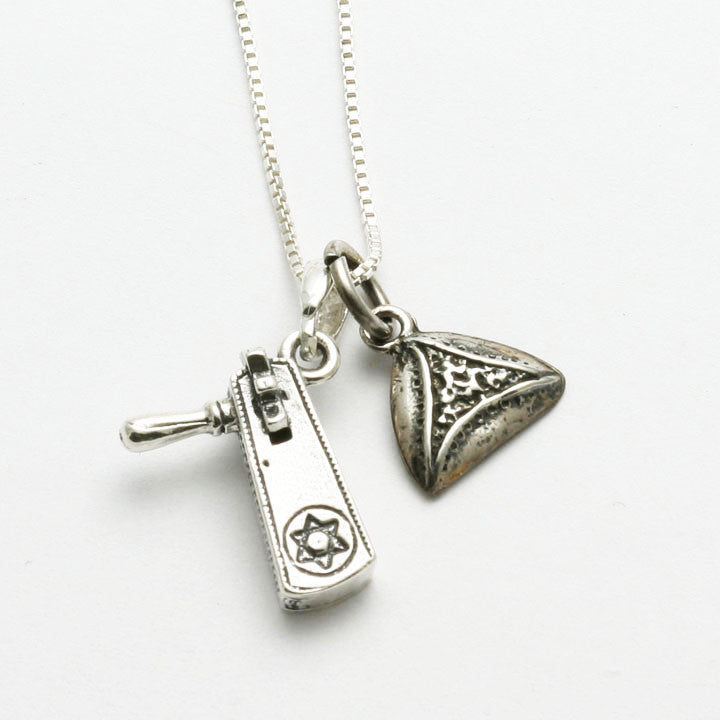
Hamantashen Recipe: Just in time for Purim!
Here is our favorite Hamantashen Recipe (Dairy)
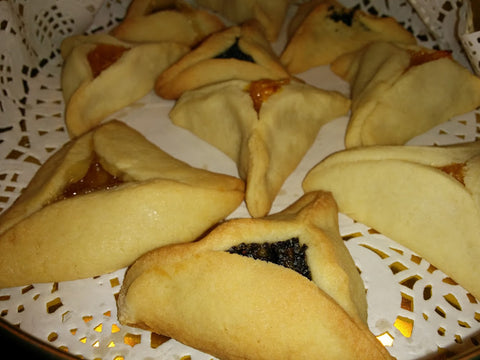
Makes about 24:
1/2 cup unsalted butter
1 cup sugar
2 tbsp milk
1 egg, beaten
1 tsp vanilla extract
pinch of salt
2 cups all purpose flour
Powder sugar for dusting (optional)
For apricot filling:
1 cup dried apricots
1 cinnamon stick
3 tbsp sugar
For poppy seed filling:
1 cup poppy seeds, coarsely ground
1/2 cup milk
1/2 cup golden raisins, coarsely chopped
3-4 tbsp sugar
2 tbsp golden corn syrup
1-2 tsp grated lemon rind
1 tsp vanilla extract
(1) Cream the butter and sugar in a large bowl until pale and fluffy. Mix together the milk, egg, vanilla and salt in another bowl. Sift the flour in a third bowl.
(2) Beat the butter mixture with 1/3 of the flour. Gradually add the remaining flour, alternating with the milk mixture. If the dough is too stiff, add a little extra milk. Cover and chill for 1 hour.
(3) To make the apricot filling, put the apricots, cinnamon and sugar in a pan and add enough water to cover. Simmer for 15 minutes or until the apricots are tender and most of the liquid has evaporated. Remove the cinnamon stick then puree the fruit in a food processor or blender with a little of the cooking liquid to the consistency of thick jam.
(4) To make the poppy seed filling, put all the ingredients, except the vanilla, in a pan and simmer for 5-10 minutes until the mixture has been absorbed. Stir in the vanilla.
(5) Preheat the oven to 350 F. Roll out the dough on a lightly floured surface to 1/8-1/4 inch thick. Stamp out 3" rounds with a plain cutter.
(6) Place 1-2 tbsp of filling in the center of each round, then pinch the pastry together to form three corners, leaving a little of the filling showing in the middle.
(7) Place the pastries on a baking sheet and bake for 15 minutes, or until pale golden. Serve the pastries warm or cold, dusted with icing sugar, if you like.
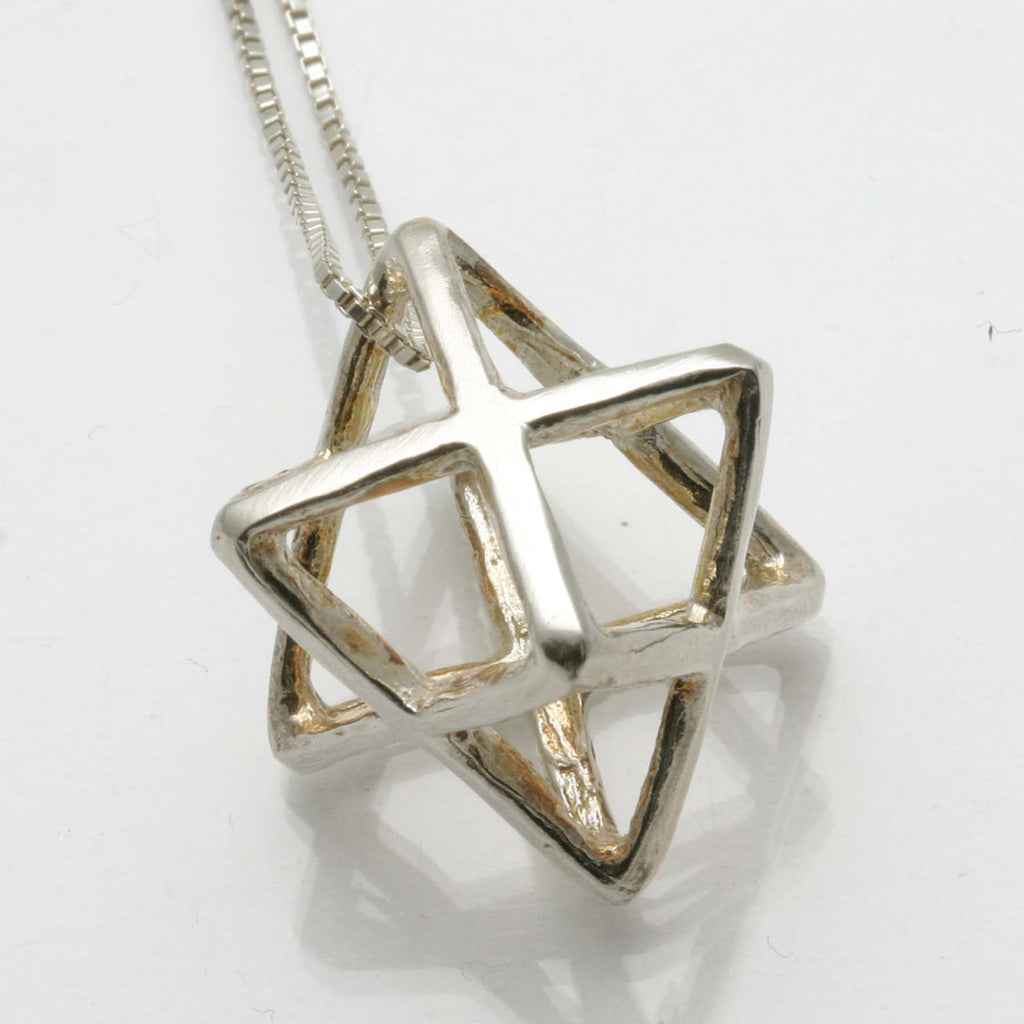
Hanukkah Gift Ideas from Jewelry Judaica
Thanksgiving is almost here which means... it's time to start your holiday shopping! Hanukkah begins on Sunday December 6th, so we at Jewelry Judaica decided to give you an entire week of Black Friday / Cyber Monday savings. We put our entire collection on sale, 25% off! That is the biggest sale of the year!
To help you decide what to buy, here is a handy gift guide of our best sellers for all the loved ones in your life!
Young girl:
Young boy:
Adult woman:
Adult man:
Grandmother:
Did we miss someone? Let us know in the comments below and we will be happy to give you our recommendations.
Happy Thanksgiving! Enjoy your time with your family and friends.
Best,
The Jewelry Judaica Team
Ten Common (and Less Common) Jewish Jewelry Motifs Explained
As one would expect from a nearly 4,000 year-old culture, Judaism is full of religious symbols and iconography. Many of these motifs are commonly used in Jewish art and jewelry. Below we explore some of the most common (and less common) Jewish jewelry motifs. These motifs are sometimes used individually but are often combined with one another in beautiful and original ways…
1. Star of David
The Jewish Star is the most popular symbol associated with Judaism around the world and perhaps the most popular motif for Jewish jewelry. Also called a "Magen David," or "Shield of David," the symbol is said to originate from the shield of the Israelite King David, though its actual origins are not completely clear. In fact, the Jewish Star is a relatively young Jewish symbol and its popular use only dates back a few hundred years. There are many symbolic and Mystical theories about the theological significance of the shape of two intertwined triangles.
Jewish Star of David Pendant
2. Mezuzah
Jews are commanded to affix mezuzahs to their door posts to remind them of G-d's presence and commandments in their daily lives. A mezuzah is actually a handwritten parchment paper inscribed with Torah verses. This parchment (klaf) is then rolled up and placed inside the familiar decorative (and protective) case we typically see. Mezuzah cases often prominently feature the Hebrew letter “shin,” or the word “Shaddai,” one of the names of God, and an acronym meaning “Guardian of the doors of Israel.”
The mezuzah has become a strong symbol of divine protection in Judaism. As such, the mezuzah is a popular motif for jewelry, however, one does not find a “kosher,” handwritten klaf in a mezuzah pendant.
Mezuzah pendant with "shin" and Jewish Star
3. Hamsa
The Hamsa, meaning “five” in Arabic, is a hand-shaped symbol that has significance to Jews, Muslims and many Christians. It is a common amulet among North African and Middle Eastern cultures that is said to ward off the evil eye and offer protection. It is a very popular good luck charm and often incorporates other motifs, such as an eye, chai or star.
Hamsa pendant with eye motif
4. Chai
Chai is the Hebrew word for “living,” made up of the letters “chet” and “yod.” The word is a popular symbol in Judaism. Interestingly, the Hebrew numerology of the letters that spell the word correspond to the number 18, making 18 a significant number in Jewish gift-giving. Both the chai motif and the number 18 represent long life and prosperity and the chai has become a popular jewelry motif.
A gold chai pendant
5. Ten Commandments/Torah
According to Jewish Tradition, God gave the Ten Commandments and Torah to Moses and the Israelites at Mt. Sinai soon after their exodus from Egypt. The Torah, the core of the Jewish faith, consists of the written Torah as well as the Oral Law, a tradition passed down for many centuries before being written as the Mishnah.
As such, it is not uncommon to see Jewish Jewelry motifs that depict the Ten Commandments or a Torah scroll as a representation of the theme of Torah, the central aspect of Jewish faith and tradition. Of course, the Ten Commandments is also a popular Christian design motif.
Ten Commandments tablets pendant
6. Shema Yisrael
The word “Shema” is the Hebrew imperative form of the word “hear” and “Yisrael” is the Hebrew for “Israel.” “Hear, Israel…” is the beginning of a section of Torah that is also a central Jewish prayer recited twice daily. The complete first line reads: “Hear, Israel, The Lord is our God, The Lord is one.” The prayer is an affirmation of one God and the acceptance of God’s commandments. The Shema passage is also written in the mezuzah.
Shema Yisrael pendant in the style of a flame
7. Menorah
The menorah was a seven-branched ritual candelabrum constructed of pure gold by the Israelites after the exodus from Egypt. It was used in the worship of God in the wilderness and later, in the Holy Temple in Jerusalem. Prior to the emergence of the Jewish Star, the menorah was probably the most widely used Jewish symbol.
Menorah pendant
The words “Ani Le’dodi Ve’Dodi Li” come from the Biblical book Song of Songs (or Song of Solomon). The translation is “I am my beloved’s and my beloved is mine.” The book consists of descriptive poetic expressions of passion between lovers, taken traditionally as an allegory of the love between God and Israel.
Today, this passage is very popular for some as an expression of love between a husband and wife and some Jewish women choose to speak these words to their husband on their wedding day. It is also sometimes depicted on pendants and inscribed on wedding bands.
Ring engraved with Hebrew "Ani Le'dodi"
9. Dove
Since the story of Noah and the great flood that nearly destroyed the world, the dove has been a universal symbol of peace and hope. Many people around the world embrace the dove as an expression of optimism for a better future. In Jewish jewelry, the symbol is often combined with other motifs, such as the Star of David or hamsa.
Dove and Star of David pendant
The theme of the Land of Israel, and more specifically Jerusalem (sometimes referred to as Zion), has been a common theme within Jewish culture and art for millennia, especially for diaspora Jews who longed to return to the Promised Land. Sometimes Jerusalem is represented in jewelry form as the Kotel, Wailing Wall or Western Wall, a remnant of the Jewish Temple perimeter wall in Jerusalem and a symbol of redemption.
Western Wall-themed pendant with Star of David
Star of David pendant with the Hebrew word "Zion"
The Menorah is an Enduring Jewish Symbol
Dating back nearly 4,000 years to Abraham, the Jewish People have developed a rich religious and cultural heritage. Like many cultures and faiths, Judaism has many significant objects and traditional symbols. Just a few include the tallit, tefillin, kippah, seder plate, kiddush cup, Shabbat candles, besamim (havdalah spices) lulav and etrog, and of course, the Ten Commandments and Torah. One of the oldest and most enduring symbols of the Jewish culture is the menorah.
The menorah was a seven-branched candelabrum of intricate detail and pure gold construction. It is described in the Bible as God instructs Moses to build it to be used in the Tabernacle, or Mishkan, a portable sanctuary constructed in the desert to worship God after the Israelite exodus from Egypt. The menorah was lit each day using pure olive oil and was operated by the Kohanim, or Jewish priests. It would later be used inside the Temple in Jerusalem.

Above: Depictions of the menorah in the Temple. It is uncertain if the branches of the menorah were straight or curved.
The fate of the original menorah is uncertain. It is believed that the menorah used in the Second Temple was looted when Rome sacked Jerusalem in 70 AD, as depicted by a relief carving on the Arch of Titus in Rome.
Even if its whereabouts were known, like many religiously significant objects described in the Torah, the menorah has no practical use so long as there is no Jewish Temple on the Temple Mount in Jerusalem. However, the menorah endures as an important national symbol of the divine “light” of Torah and of the responsibility of the Jewish People to follow its laws. Today, the menorah is the official symbol of the state of Israel and is featured prominently on the state’s emblem.

Above: Emblem of the State of Israel featuring a menorah
The menorah is also often found as a decorative motif in Jewish artwork and jewelry, though this motif is perhaps less common than some other Jewish symbols, including the ubiquitous Star of David.
Above: A Star of David pendant features a menorah design
The Ner Tamid
The menorah’s enduring symbolism led to the creation of the ner tamid. The ner tamid, or eternal light, is a lamp typically found in Jewish synagogues above the ark that houses the Torah scrolls. Following the destruction of the Second Temple, community synagogues emerged as the primary place of Jewish worship and these lights became symbolic analogs of sorts for the menorah. As its name suggests, the ner tamid is a light that is never turned off, much as the menorah and altar were constantly lit in the Temple in Jerusalem.

Above: A ner tamid in a synagogue
The Hanukkiyah
Another Jewish object that is evocative of the menorah is the hanukkiyah (hanukkiah), or Hanukkah menorah. Though the hanukkiyah is a nine-branched candelabrum, whereas the menorah had seven branches, the typical hannukiyah’s branched appearance is clearly similar to that of the Temple menorah. The connection is purposeful as the hanukkiyah was designed to remind Jews of the well-known Hanukkah miracle involving the menorah.
In 201 BCE, the Seleucid (Syrian-Greek) Empire conquered Judea and made it a client state. In 168 BCE, the army of King Antiochus IV sacked Jerusalem, defiled the Jewish Temple, and imposed a series of laws against Jewish customs and worship. This led to the Maccabean Revolt against Hellenistic rule and influence in Judea. Following the defeat of the Seleucid army and the recapture of Jerusalem, a single day’s worth of oil miraculously burned in the Temple menorah for eight days; long enough for the Jewish priests to make new oil as they purified the Temple’s religious objects and rededicated the Temple to God. The word “Hanukkah” actually means “dedication” and Jews are commanded to remember this event by lighting the Hanukkah menorah during the eight nights of the Hanukkah holiday.

Above: A lit hanukkiyah
Recipe: Amazingly Simple Spicy Sriracha Schnitzel
Everyone loves schnitzel. If you don't, your loss.
Since I got married, I've become somewhat of a schnitzel maven. Eaten with hot mustard, it's one of my absolute favorites. Even my wife, who doesn't love chicken, looks forward to schnitzel night. Recently, I started experimenting with adding flavors to the egg wash, cause why leave a good thing alone... After a bit of trial and error, sriracha sauce is the clear winner. Here's my very simple recipe:

- 1 package (1-1.5 pounds) thin "schnitzel' cut chicken breast
- 2 large eggs
- Bread crumbs (Any will do but I like Osem's Homestyle with Sesame)
- Sriracha sauce
- Peanut Oil (or any frying oil)
Start by trimming the chicken. Of you don't have schnitzel fillets, you'll want to butterfly the breast. Brine the chicken by placing the pieces into a large bowl of well-salted water (about a cup of salt per gallon). You won't need to leave it in long for the chicken to take in the brine since it is cut thin; between 30 and 60 minutes. This step will help keep the chicken moist when frying and you won't need to add salt. When enough time has passed, remove the chicken and dry it thoroughly with paper towel (so the other ingredients will adhere well) and then cut into strips.
Crack 2 eggs and whisk in a smaller bowl. Add approximately 2-4 tbsp sriracha sauce (to heat level desired) and mix well. For my basic recipe, I hold the sriracha.

I generally don't coat the chicken in flour before dipping in the egg mixture but you definitely can if you like. Dip the chicken in the sriracha and egg mixture and then dredge in bread crumbs.
Heat about 1/4 inch of oil in large frying pan and pan fry both sides of chicken until golden brown on both sides.
Let cool on paper towel to absorb excess oil. Enjoy!
BTW this is my favorite mustard with which to enjoy schnitzel: Silver Spring Beer'n Brat horseradish mustard.

A Personal Reflection on Lag B’Omer and Israel
When I was in college, I had the opportunity to live in Israel and study at Tel Aviv University. It was the best time of my life. I had been to Israel so many times before on vacation, but this was my first opportunity to live there and take in all that the amazing country has to offer. Interestingly enough, one of my strongest memories from living in Israel is celebrating Lag B’Omer. Lag B’Omer is not one of the most important holidays. There are no special prayers or special foods, it’s just a time to celebrate.
I was pleasantly surprised to see that in Israel, everyone participates in Lag B’Omer festivities. Every empty lot has a little bonfire in it. You see kids everywhere, whole families huddling around cooking their potatoes in the fire. It’s a true sensory experience. You can see and smell the holiday everywhere you go, and the smell of the smoke and fire lingers for the next few days! It was so exciting to see the joy and excitement in the masses of people standing in the streets together.
That’s the thing about living in Israel. You don’t have to be religious or observant to feel your Jewish identity. Living there, the language is Jewish, the culture is Jewish, the air you breathe is Jewish. Many Israelis probably don’t know or care that this day marks the end of the plague that killed the students of Torah sage Rabbi Akiva or that we light bonfires is to celebrate the life of his disciple, Rabbi Shimon Bar Yochai. On Lag B’Omer in Israel, it’s not about religion for most people. You simply participate, you celebrate, you live life.
As I reflected on this memory, it got me thinking about Israel today. With Lag B’Omer as an exception, many secular Israelis equate observing Jewish holidays with being “religious.” And in Israel, being religious is a stigma and the source of many political fights. As a Jew (traditional but not religious) living in the diaspora, it saddens me (although I do understand where it comes from) to see how much hatred and negativity are placed on religious Judaism by Jews who consider themselves “Jewish enough” just because they live in Israel.
Obviously, this feeling is unique to Israel. When many of these same anti-religious Israelis leave Israel to live in the diaspora, they realize that Judaism was a bigger part of the fabric of their being than they ever realized. They begin to seek out Judaism because they miss it. They long for it. And they finally see that for most of the world’s Jews and throughout most of the history of the Jewish people, Jews have had to work at maintaining a Jewish identity. Now, these former ridiculers of Judaism are planning large Rosh Hashanah dinners and Passover seders. And they still head down to the beach for a bonfire on Lag B’Omer. Only now, they realize how lucky they were to have lived in such an amazing country where they got to live, eat, and breathe Judaism without even trying.
Baking for Purim with the family is so satisfying!
Purim has always been one of my favorite Jewish holidays. Not only do I love the story and the message of Purim – you can keep trying to kill us, but we Jews are here to stay, but I love all the customs that go with it. As a kid, attending our school Purim carnival was the highlight of my year. The costumes, the excuse to have fun, rejoice and be proud to be a Jew. Now that I’m older and I’ve basically outgrown the dressing up and Purim carnivals, I look forward to the parties, drinking and of course, my favorite, hamantaschen.
For the past few years I’ve been making my own hamantaschen from scratch, including the fillings. And I’ve made it a family event, teaching my niece and nephews the recipe and techniques and making it a fun activity for everyone. And it has paid off. When they hear Purim is coming up; their first question is, when can we make hamantaschen? For me that is a small victory in the preservation of our culture. I’m happy that they have a strong association with this holiday, even if it seems like it’s just about dessert, it’s really so much more.
I’ve been really happy with the cookie dough-like recipe that I found. It was the first recipe I ever tried and it’s been a winner. This year, with the explosion of Purim on social media (especially Pinterest and Facebook), I started thinking about Hamantaschen earlier than usual. Everywhere I looked were the most amazing DIY mishloach manot baskets and creative sweet and savory hamentaschen recipes. As much as I would love to try them all, I work full time and just don’t have the time. Then I saw the article “Thanks but no thanks, Purim Pinterest” on Kveller, and even though I love baking and crafting, it definitely resonated with me.
So while I fully recognize that I’m only human and can’t do EVERYTHING I want to do, I decided to just try to add two new fillings to hamantaschen repertoire. The recipe that called out to me the most was for Tagalong hamantashen (probably because Girl Scout Cookie season just ended). So when I made my first batch of hamantashen last night, I set aside some dough and filled it with a peanut butter mixture and dipped the bottom in melted chocolate. And the result… DELICIOUS!
I generally make apricot and poppy seed filling. This year I also added a spiced pear filling (I have a thing for pears and it was delicious). So I ended up with 4 delicious hamentashen flavors.
"Tagalong" hamantaschen recipe:
http://www.myjewishlearning.com/blog/food/2015/02/17/tagalong-hamantaschen/
Disclaimer: The recipe I linked to calls for a shortbread style cookie dough. I just used my regular cookie dough and it came out perfect.
PB&J challah is delicious. You should try some. But not this one. This one is mine. Make your own.

If you've had it, you know how darn good fresh challah is. It's warm, yeasty, spongy, a little chewy, a little eggy, a little awesome. It happens to be one of the most delicious parts of the Sabbath meal, or any meal for that matter. It's not only a traditional part of Jewish culture, but it's also an important mitzvah for women.
At JewelryJudaica.com, we sometimes keep things traditional, but then again, sometimes we don't. Recently, we were inspired to take our traditional family challah to the next level. Not that regular challah needs any improvement, really, but making flavored challahs can be a nice change. This time it was peanut butter and jelly challah. Sure, its been done before, but not by us! This was also my first time making challah so I was learning the basics along the way from my wife.
We typically make a four braided challah with a recipe as follows (makes two loaves):
- 2 1/2 cups warm water
- 1 tbsp yeast
- 1/2 cup honey OR 3/4 cup sugar
- 1/4 cup oil
- 4 eggs
- 1 tbsp salt
- 8 cups flour
- 1 egg, beaten for brushing
Directions:
Sprinkle the yeast into warm water and let it activate for 1-2 minutes. Mix in the eggs, oil, salt, and honey (or sugar). Add the flour, one cup at a time. Knead for 10 minutes.
Set aside in a well-oiled bowl and cover with a moist towel. Let rise for 2 hours, or until double in size.
Shape the challah* (using extra flour as necessary) and brush on beaten egg.
Set in pan and let it rise for another hour.
Bake for 30-40 minutes in a preheated oven at 375 degrees F.
*For the PB&J variation, we separated the challah into 4 pieces when getting ready to braid. Normally, we'd roll these into roughly 15" strips and then braid. But this time, we flattened out the strips, smothering two each with peanut butter and raspberry preserves (we used preserves because of the solid consistency) and then rolling them up. Strawberry or grape would be good too, I think.

Then braid as usual.


My wife taught me to braid but my braiding technique clearly needed work. I've since improved, I promise.

A bit of leakage here. Did we overfill the challah with preserves or just not seal it well enough?

Looks aside, this challah turned out to be quite delicious! It was especially good fresh. Basically, it tasted like a freshly baked PB&J challah sandwich.

It was also amazing as french toast. Dessert breakfast, anyone?
Let us know if you try this recipe. We'd love to hear your thoughts!
A Reflection on Hanukkah
Hanukkah is probably a Jewish child's favorite holiday. Presents, dreidels, jelly donuts, presents, decorations, presents. Some people think that Hanukkah has become a bit too commercialized, too materialistic. They have a point. Our great grandparents would scarcely recognize the concept of giving extravagant presents on Hanukkah, let alone eight gifts, as some do. Back in the day, Hanukkah was a fairly minor holiday and a child might receive a few coins, a bit of "gelt," from dad or grandpa. But today, many American Jews feel they have to compete with Christmas.
It’s probably not a coincidence that the scale of Hanukkah has expanded over the years to match the growing commercialization of Christmas. Christmas is flashy, bright, and culturally dominant. It's an obvious draw for children, Christian or not. And with Jewish assimilation rates as high as they are in the predominantly Christian United States, many Jewish parents probably feel (even subconsciously) they have to keep the attention of children who see the appeal of Christmas all around them this time of year. It's not enough to say, "Christmas is great, but it's not our holiday. Here, eat some donuts." Many Jewish parents are now like, "Open your eight gifts. See, our holidays are just a cool as theirs. Stay Jewish, kid."
In fact, there are parallels between this phenomenon and the Hanukkah story. Hanukkah is an historic account of an outmatched band of Jewish guerrillas who fought the active and passive attempts by Greeks and Jewish elitists to assimilate the Jewish people into the dominant Greek culture. The Maccabees fought to preserve Jewish culture, ultimately winning their religious freedom from Greek occupiers. Unlike the Greeks of the time, The United States is an overall benevolent force for Jews, but the struggle to preserve one's identity as a cultural minority continues today.
The truth is, I don't really care why Hanukkah has become such an important holiday for American Jews because, at the end of the day, Hanukkah is a pretty awesome, rich holiday with important messages. And giving and receiving gifts is pretty nice too, provided we don't lose sight of the deeper meaning of the holiday.
The Hanukkah story is about a fight for the preservation of Judaism but it is also a story of miracles; miracles throughout the history of the Jewish people and a reminder that miracles can happen today. This is symbolized by lighting the chanukiah, or menorah, commemorating the miracle of a single day's worth of oil that burned for eight days in the rededication of the Holy Temple.
The symbolism of the light has powerful meaning today, as it did then, of mitzvot, goodness and positivity triumphing over evil and negativity. Even when it seems like there is no end to the darkness and wickedness in the world, a seemingly small force can help us restore light and positivity, sometimes with the help of a miracle or two.
One of the best Hanukkah songs sums it up well:
בָּאנוּ חוֹשֶׁךְ לְגָרֵשׁ
בְּיָדֵינוּ אוֹר וָאֵשׁ
כָּל אֶחָד הוּא אוֹר קָטָן
וְכֻלָנוּ אוֹר אֵיתָן
סוּרָה חוֹשֶׁךְ הָלְאָה שְחוֹר
סוּרָה מִפְּנֵי הָאוֹר
We came to banish the darkness
In our hands are light and fire
Each individual is a small light
And together our light is mighty
Away darkness, begone blackness
Away from the light
----------------------------------------------
All of our Hanukkah-themed jewelry can be found here. Some examples below:
Please Forgive Me and G'mar Chatimah Tovah!
Yom Kippur is just a couple days away. That means our fates are nearly sealed for this year. But it’s not too late to atone!
Rosh Hashanah and Yom Kippur are probably the most religiously observed Jewish holidays. Anyone who’s been to a synagogue on these holidays knows how they swell to accommodate the masses who don’t normally set foot in a shul. And for good cause. The "high holidays" are the time when we as Jews try to "return" to God, if only for a short time, to plead for another year; perhaps a better year. As of Rosh Hashanah, the verdict on each of us has already been inscribed in the book of life. But it isn’t until the end of Yom Kippur that our fate is finalized, sealed and filed away for the year.
According to the Torah, God will cleanse us of our sins if we atone. He’s pretty merciful like that. However, that type of forgiveness only applies to sins committed against God. What God does not forgive are transgressions against people. Jewish tradition holds that we can only be forgiven by the very people we hurt. Easier said than done, sure. But then again, the humbling experience of truly asking for forgiveness is why it is so powerful and important.
Good news is, it’s not too late to ask for forgiveness from those we hurt and it’s not too late to grant it to those who hurt us.
We wish you a g’mar chatimah tovah, a good final inscription [in the Book of Life]. May this year be the best one yet! Please forgive me if I hurt you in any way. And I forgive you without reservation! =)
---
More on asking for forgiveness here.
Hopeful During these Nine Days of 2014
The world is always a very dangerous place. Innocent people are suffering and dying at the hands of violent thugs wherever you look, from Syria and Iraq to Nigeria and Mexico. Most of us feel helpless to stop it. Even with a strong Israel to defend the Jewish people, there’s uncertainty about the outcome of Israel’s situation with Hamas, mounting pressure from the US and the UN, and the global rise in anti-Semitism cloaked as anti-Zionism. These would be valid concerns at any time, but today feels a bit more ominous because of the timing.
Historically, this time of the year is a period of danger, mourning and refrain for the Jewish People known as the “Nine Days.” These days commemorate the sorrowful final lead up to the Ninth of Av (Tisha B’Av), a date of historical infamy on which numerous tragedies befell the Jewish People. It is said that both the First and Second Holy Temples were sacked on that date. Among other tragedies to fall on this date, the Bar Kochba Revolt was brutally crushed by the Romans, the Jews were expelled from England in 1290, and again from Spain in 1492. Additionally, World War I, which led directly to World War II and the Holocaust, began on that day. Most chillingly perhaps, it was also the day that the Nazis formally approved “The Final Solution.” Sadly, Tisha B’Av has a way of making itself dreadfully relevant for the Jewish nation [and the world].
As an aside, it may be of some interest that Israel’s unilateral disengagement, or self-extrication from Gaza, was delayed in 2005 so as not to coincide with the Nine Days and instead began on the 10th of Av. Yet this date too is meaningful as, while the Temple was set ablaze on the 9th, it burned for two days and Jews therefore refrain from certain comforts on the 10th as well. In fact, the entire month of Av is considered bad luck in Jewish tradition. Considering the current fallout and looking back, setting the timing of disengagement to coincide with such a period of bad luck is just a bit unsettling. Whatever side of the political fence you’re on, it is clear that Israel’s Gaza disengagement facilitated the conditions that led directly to the current fighting, suffering and deaths of far too many people today.
This year, the lead up to Tisha B’Av is an especially difficult time for those mourning Israel’s fallen and those in Israel living under constant threat. This year, the sorrow is not a distant collective memory. We don’t need a reminder to mourn because our mourning is fresh, our uncertainty is real and the atmosphere around us truly matches that of the Nine Days. But Tisha B’Av is less than a week away and with it has sometimes come new misfortune. But I choose to be optimistic about the future.
It is said that the last Holy Temple was destroyed because of baseless hatred that tore apart the Jewish People within their homeland. Today, I see quite the opposite. I see strong unity and positivity among Jews when it comes to their love and defense of each other and of their homeland. As individuals and as a nation, when we choose to be positive, work together, and hope and pray that goodness will prevail, we are all stronger, even during tough times. Let us hope that we have seen the worst and that things get better from here. Let us hope that the current unity of Israel and the Jewish people continues to lead to positivity, strength and peace, not just for Israel, but for people all around the world. With less than a week left until Tisha B’Av, let us pray that we never have to add another catastrophic event to the infamous 9th of Av list.
Am Yisrael Chai!
Israeli Flag Star of David pendant.
A Bar Mitzvah Gift Guide: Hint, Money Makes a Good Gift
Everyone struggles with gift ideas when they get invited to a bar mitzvah, especially if they haven’t been to one in a while and are out of the loop, so to speak. Money is a good option but what is the appropriate amount to give? What non-monetary gifts do “young people” want these days? After talking to some boys that recently celebrated their bar mitzvahs, we have compiled this gift giving guide to help give you some suggestions.
The most common gift, of course, is money! Traditionally monetary gifts are given in multiples of 18. In Hebrew, the word for “life,” “chai,” corresponds to the numerical value of 18. Giving a gift in a multiple of 18 ($36, $54, $180, etc.) is a symbolic blessing to the recipient for a long life.
So how much should you give? That answer always depends on how close you are to the bar mitzvah boy, how many family members are attending the simcha, and of course what you can allow yourself to give based on your financial situation. There is no straight forward formula, but here is some data that we collected:
Most friends of the Bar-Mitzvah boys that came solo gave between $18-$54, with a modal value, or most common gift of around $36. Couples gave between $72-$180, and families anywhere between $100 and $360. Of course there were a few close family friends and relatives that gave much more. Some people also gave $280. In Judaism, the number 28 numerically corresponds to the word “koach,” or “strength,” which is also another multiple people like to use when deciding on a gift amount. Monetary gifts came in cash, checks, Israel bonds and of course iTunes and Amazon gift cards.
 Money is good, but some people like to add a personal touch to their gift-giving. We found that aside from money, other stand out gifts were often Judaic items. A sterling silver kiddush cup, a yad (pointer used to read from the Torah), a tallit, tefillin (phylacteries), and a handmade kippah (yarmulke) were among the favorite Jewish-themed gifts received by our bar mitzvahs. These were mostly given by close family members, so if you want to get any of these items, I would suggest checking with the parents of the bar mitzvah first. Many of these are items that may be given prior to the bar mitzvah ceremony so that the bar mitzvah boy can use them on his special day. Some other Judaic items that you can consider are a shofar, tzedakah (charity) box, Jewish books or even a new mezuzah for the bar mitzvah’s room.
Money is good, but some people like to add a personal touch to their gift-giving. We found that aside from money, other stand out gifts were often Judaic items. A sterling silver kiddush cup, a yad (pointer used to read from the Torah), a tallit, tefillin (phylacteries), and a handmade kippah (yarmulke) were among the favorite Jewish-themed gifts received by our bar mitzvahs. These were mostly given by close family members, so if you want to get any of these items, I would suggest checking with the parents of the bar mitzvah first. Many of these are items that may be given prior to the bar mitzvah ceremony so that the bar mitzvah boy can use them on his special day. Some other Judaic items that you can consider are a shofar, tzedakah (charity) box, Jewish books or even a new mezuzah for the bar mitzvah’s room.
Other Jewish-themed gifts included our favorite, Judaica jewelry. Usually given by close friends or family members, the most traditional jewelry gift for boys is a yellow gold pendant. When choosing their own pendant, boys generally pick a classic Star of David pendant, chai pendant or a mezuzah pendant. Some other great ideas are sterling silver Star of David cufflinks (that can be worn on his bar mitzvah), a sterling silver Star of David dog tag necklace, or a sterling silver chai ring.
A few other “honorable mention” gifts received by our new men of the hour were sports memorabilia, including signed balls or jerseys from a favorite athlete, a special trip with the bar mitzvah boy, a computer, and a console gaming system. We also saw people buy the bar mitzvah financial stocks, make donations in his name to a favorite charity, and plant trees in Israel in his honor.
For more ideas, check out our Bar-Mitzvah Gift board on Pinterest!
What's the best bar mitzvah gift you received or heard of someone getting? Let us know! Here are some of our favorites below:
A simple, traditional yellow gold Star of David is a great gift.
Another simple design, this chai is a very popular men's pendant.
A very nice 14K Yemenite style mezuzah pendant.
A contemporary style Star of David in the style of Israeli Army dog tags.
Jewish Star cufflinks. Bar Mitzvah cool factor: 10.
Silver chai ring. A man's ring.



